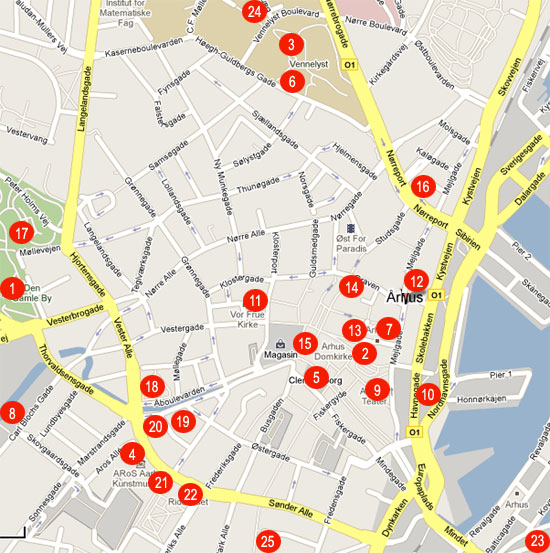Aarhus (Århus) - Tourist Attractions

1. The Old Town (Den Gamle By). The Old Town (Den Gamle By) is an open air museum consisting of 75 historical buildings collected from 20 different towns across the country. The buildings were taken to their current location and rebuilt stone by stone to create the beautiful village you see today. The Old Town is must see attraction for those interested in history. You could say that is a must see for anyone visiting Aarhus. It is one of the finest tourist attractions in all of Denmark. ‘The Old Town’ is particularly interesting leading up to Christmas. Every year around Christmas ‘The Old Town’ is beautifully decorated giving it a wonderful atmosphere. The oldest houses date back to the 15th century. The village itself could easily stand on its own as a great attraction. However, an added feature is that most buildings are open for visitors. Inside the buildings you can see how bakers, carpenters, grocers, clothing manufacturers conducted their business prior to the industrial revolution. Throughout the village there people working in the roles of a typical village figure. All of the people playing a role in the town have vast knowledge of the ‘characters’ they are portraying, and they are more than willing to answer any questions you may have. All of the ‘characters’ in the town speak excellent English. The Old Town (Den Gamle By) does a tremendous job at portraying a functioning pre-industrialized Danish village.
2. Aarhus Cathedral (Århus Domkirke). This Cathedral is 93 m long which makes it the longest in church/cathedral in all of Denmark. The cathedral seats 1200 people. The original Cathedral was built in the beginning of the 12th century; however in 1330 the church was destroyed by fire. Bricks from the original Cathedral were used in the construction of some sections of the walls on the current building which was building in 1449. The cathedral contains more frescos than any other cathedral in Denmark. The detailed decoration of the cathedral is truly amazing; however you would actually need binoculars if you wanted to see the fine details.
3. The Natural History Museum (Naturhistorisk Museum). This is a decent Natural History Museum which tells the story of the nature and landscape changes in Denmark over several millennia. The museum has an interesting collection of hominid skeletons. There are also many stuffed and preserved animals from all over the world. Many of the preserved animals have been extinct for thousands of years.
4. ARoS Aarhus Art Museum (ARoS Århus Kunstmuseum). This 10 storey, 17,000 m² museum is one of the largest art museums in northern Europe. The local architectural company Schmidt, Hammer and Lassen designed the Aros Aarhus Art Museum in 2004. This is the same company which designed the famous Black Diamante (Den Sorte Diamant) building in Copenhagen (København). Aros is the original name for Aarhus. The museum is divided into three different permanent collections: The Danish Golden Age (1770–1900), Danish Modernism (1900–1960) and contemporary art. The museum also includes a progressive art gallery called ‘The 9 Spaces’, which is installation art, where 1 or 2 rooms are done each year. ARoS features a shop, café and restaurant.
5. Stroget (Strøget). The Stoget (Strøget) is the long walking street in Aarhus. The walking street begins at the Aahus Cathedral and ends at the train station square. The walking street is mainly a shopping street. However, there are also numerous cafes and restaurants.
6. The Steno Museum (Steno Museet). This rather unique museum shows the development of science in relation to medicine. The Museum’s herb garden has more than 350 different plants which have at one time or another been used as a form of medicine. There is a modest multimedia show about the fascinating world of astronomy which can be seen in the planetarium of the museum. The planetarium also houses several historical and modern day astronomical telescopes.
7. The Women’s Museum (Kvindemuseet) and The Museum of Occupation (Besættelsesmuseet). In 1857 the city hall was torn down and a new one was erected. From 1941-1983 this building was used as a police station. Today the building contains two museums. The Women’s Museum which tells the story of the cultural history of females both globally and within Denmark. The second museum is the Museum of Occupation (Besættelsesmuseet) which is located in the basement of this building. The Museum of Occupation tells the story of the city during the German Occupation from 1940-1945 during World War 2.
8. Aarhus City Museum (Århus Bymuseum). The Aarhus City Museum is located in the old railway station building. The museum does an excellent job at telling the local cultural history of the development of Aarhus, from the Vikings time up until the present. The museum organizes walking tours during the summertime. Open year round except from Christmas and New Year.
9. Aarhus Theatre (Århus Teater). The Theatre was built in 1900, and it was designed by the Danish architect Hack Kampmann (1856-1920). The building was built in the popular building style of the day, ‘Art Nouveau’. The building style of the theatre has a notable national romantic emphasis on natural materials. The façade of the theatre building is very fancily decorated. The interior of the theatre is decorated with Danish nature motifs. The artists Hansen-Reistrup and Hans Tegner completed the interior of the theatre.
10. The Customs Chamber (Toldkammeret). Close to the old inner harbour of Aarhus you’ll find the ‘The Customs Chamber’. This castle like building dates back to 1897. The Customs Chamber building is one of the finest buildings in Aarhus, and it was designed by the Danish architect Hack Kampmann.
Aarhus - Tourist Sites (Part 2)
Aarhus - More Tourist Attractions (Part 3)
Aarhus - Main Page
LastUpdate: 2019-07-07 00:12:59
